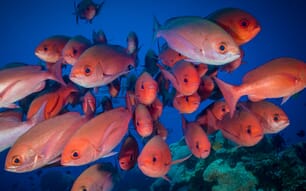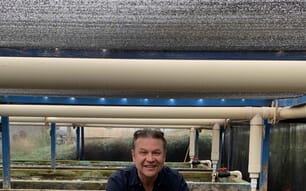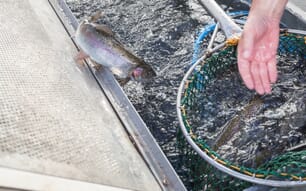The most common breed of tilapia farmed around the world is the Nile tilapia, which accounts for roughly 75 per cent of farmed tilapia.
Tilapia is a popular fish for aquaculture as it is very versatile and is tolerant of a variety of aquaculture environments; it can be farmed in brackish or salt water and also in pond or cage systems.
As an omnivorous animal, tilapia will eat diets composed of both animal and vegetable origin as well as algae/plankton. Tilapia will cope with a relatively low feed quality, making them a suitable species for feed of a lower nutritional value than might be neccessary for some other aquaculture species.
Breeding
Most farmers choose to keep only male tilapia in the grow out stage. Male tilapia have proved to be more profitable as they grow bigger and are more time and energy efficient. Female tilapia tend to waste energy and time due to breeding.
Due to the rivalry nature of male and female tilapia, most farmers try to keep only male tilapia in grow out. Various techniques are currently in use to try and produce only male tilapia offspring. A few of the genetic advances in this area are listed below.
Methyltestosterone technique (MT)
This method involves adding methyltestosterone to the juvenile diet. This effectively makes females develop as males whilst the males are left unchanged. No residue from the chemical is left in the fish at harvest as it disappears after 30 days, but this technique still faces ethical and safety issues. It has been reported that this method can cause a degree of liver damage to the fish.
To try and reduce the use of MT, other methods have been developed such as, the YY method.
YY Method
This technique produces YY chromosome males.
The first generation fry are treated with estrogen so that all XY females are produced. These are then mated with males that are known to be XY. This generation are then mated with XX females.
From this, it can then be determined which breeder fish are YY 'supermales' as they will only produce XY male offspring.
These fish can then be kept as YY breeding males.
Hatchery Systems
For best hatchery practice it is sensible to stock one male to three females. In order to prevent the females from incubating their eggs orally, the eggs should be removed. This allows for better control of hatching and allows for the female to produce the next batch of eggs.
Pond, or hapa, rearing can be used for large numbers whilst a spawning tank for smaller numbers.
Jar hatching has also been found to be a good way of hatching larger numbers with little supervision.
For creating the best health conditions and for having the most control, tray hatching can be a more affective method to use. However the drawback of this is that it is very labour intensive and therefore not the most cost effective technique.
Post-hatchery
Once hatched, fry are then collected and moved to grow out ponds.
Unlike other fish, tilapia tend to be hardier against poor water quality. Best practice states that the dissolved oxygen level should be around 4mg/l. Low oxygen levels in water often lead to mass fish deaths but tilapia can cope in dissolved oxygen levels under 2mg/l, however it is not advised to let the quality reach this low as it will affect the growth performance, quality and health of the fish.
In terms of pH, tilapia can tolerate a wide wide range but a pH over 6.5 is good for algae growth which is useful as feed for the fish.
Temperatures around 25ºc are most favoured by the fish.
Tilapia can be stocked at densities up to 60 kg/m cubed (depending on water and management conditions). However, high stocking densities may have a negative impact on growth performance and health status. Low stocking densities, however, can often lead to aggression between the fish.
Fish Killing
Despite its drawbacks, ice slurry is still the most common killing method used. This raises several welfare concerns regarding delayed loss of consciousness, adverse reactions and pain. Although the fish may become motionless, it may still be conscious for many minutes. Using ice can also lead to the fish meat quality being reduced.
A preferred method, when used correctly, is electric stunning. These systems are effective at killing instantly and maintaining fish meat quality. However this killing method needs to be carefully controlled to prevent flesh quality problems such as blood-spotting and heamorrhages.
Intersted in Tilapia? You might also like:
- New Guide to Farming Tilapia: Breeding and Hatchery
- A Guide to Farming Tilapia: On-Growing Techniques
- How to Farm Nile Tilapia
September 2013




